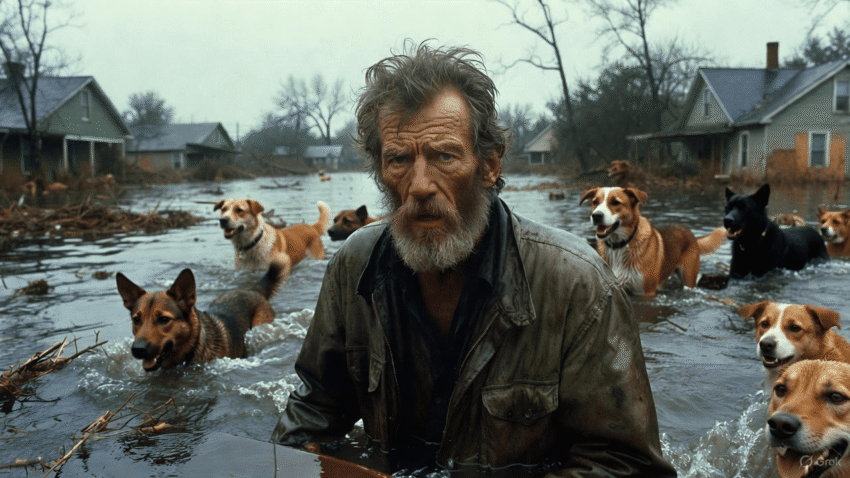On the morning of October 14, 2023, in the small riverside town of Mae Sariang, northern Thailand, 61-year-old Prasit Suksai – a homeless man everyone simply called “Uncle Dog” – waded through muddy brown water that had already swallowed the lower floor of almost every wooden house along the Yuam River. Heavy monsoon rains had fallen for nine straight days, turning streets into canals and forcing thousands to flee. Most residents grabbed their children and documents and ran. Many, in blind panic, left their dogs chained to porches or locked inside homes. That was when Uncle Dog, who had slept under the local temple’s eaves for twelve years, heard the first desperate howl. He did not hesitate. Stripping off the only dry shirt he owned, he tied it around his waist, looped a frayed nylon leash over his shoulder, and stepped into the flood. What happened next would be photographed from a rescue helicopter and become one of the most shared images of the decade.

By noon, witnesses on higher ground watched in disbelief as the old man returned again and again to the submerged neighborhood. Each time he emerged carrying or leading another dog: a trembling Shih Tzu on an improvised raft made from a plastic table, three street dogs swimming beside him guided by a single rope, even a paralyzed old German shepherd balanced across his shoulders exactly like the photograph that would later circle the globe. Local teenagers who tried to help were told, in the gentlest voice, “Go save people. The dogs have only me.”

What almost no one knew that day was that Prasit Suksai had once been someone else entirely. Forty years earlier he had been a respected army veterinarian, Captain Prasit, decorated for saving injured military dogs during the communist insurgency in the 1970s. A landmine in 1981 took his left leg below the knee and, along with it, his career, his marriage, and eventually his home. Alcohol and shame followed. For decades he drifted from town to town, surviving on temple food and the quiet companionship of the stray dogs that always seemed to find him. The flood, in a cruel twist of fate, reunited him with the very creatures he had once been paid to protect.
As night fell and the water kept rising, rescue boats finally arrived. Soldiers ordered him to climb aboard. He refused. “There are still barks,” he said simply. Only when the last audible cry fell silent did he allow himself to be pulled into the boat – with seven exhausted dogs crammed around him. In total, over the course of thirty-six hours, Uncle Dog had saved 27 dogs, two cats, and one very confused goose. The goose, locals later joked, refused to leave his side for a week.
The photograph taken from the helicopter – the one of the old man carrying the golden retriever on his shoulders like a child – exploded across social media within hours. Offers of money, housing, and prosthetic limbs poured in from around the world. News crews camped outside the temple where he was temporarily staying. Yet in every interview Uncle Dog gave the same answer when asked why he risked his life: “In the war, I promised every dog I treated that I would never abandon them. Forty years late, I finally kept that promise.”
Three months later, a foundation established in his name purchased a small plot of land on higher ground. Today the “Uncle Dog Sanctuary” is home to more than 80 disabled and elderly dogs – many of them survivors of that same flood. The man who once slept under eaves now sleeps in a tiny room filled with wagging tails. And on the wall hangs the famous photograph, framed not for glory, but as a reminder.

Every year on October 14, when the monsoon clouds gather again, the people of Mae Sariang leave bowls of food at the riverbank and whisper the same quiet words: “Thank you, Captain. The dogs never forgot you – and now neither will we.”
